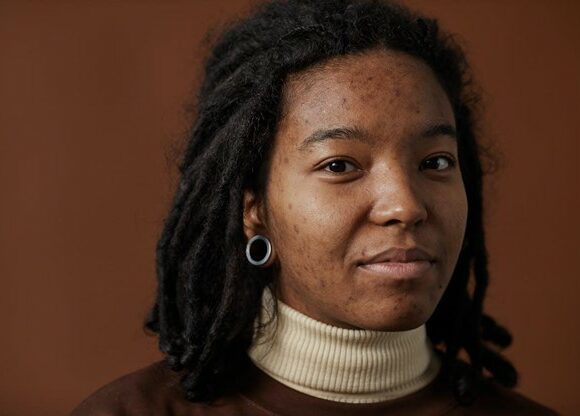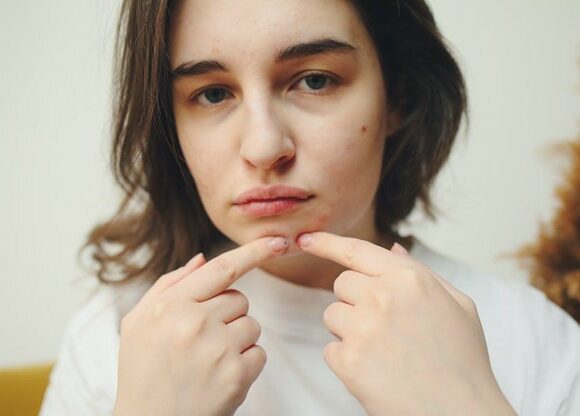Acne is a common skin condition that affects people of all ages, causing frustration and self-consciousness. It can appear in various forms, from mild breakouts to severe cystic acne. Understanding the underlying causes of acne is crucial for effective treatment.
Two common culprits behind acne breakouts are hormonal imbalances and bacterial infections. Distinguishing between the two is essential to determine the most appropriate treatment plan.
In this article, we will explore the signs and symptoms of bacterial and hormonal acne and discuss the methods used to tell them apart.

Hormonal Acne
Hormonal acne is primarily influenced by fluctuations in hormone levels within the body. It is most common during puberty, menstruation, pregnancy, and menopause but can affect individuals at any age.
The essential hormones involved in hormonal acne are androgens, such as testosterone. When androgen levels rise, they stimulate the sebaceous glands to produce excess oil, known as sebum.
The overproduction of this oily substance clogs the pores and creates an environment for acne-causing bacteria to thrive.
We also wrote an article that differentiates between fungal acne and hormonal acne: Hormonal Acne Vs Fungal Acne: What’s The Difference?
Signs Of Hormonal Acne
Hormonal acne displays several distinctive signs that differentiate it from other forms of acne. These signs include:
- Consistent pattern: Hormonal acne manifests in specific areas of the face, such as the chin, jawline, and lower cheeks. These regions have a higher concentration of sebaceous (oil) glands and are more susceptible to hormonal fluctuations. The appearance of acne in these areas is a common indicator of hormonal imbalances contributing to its development.
- Occurrence during specific times: Hormonal acne often flares up during certain periods, such as before or during menstrual cycles, pregnancy, or heightened stress. Hormonal fluctuations during these phases can stimulate the overproduction of sebum, leading to clogged pores and the subsequent development of acne lesions.
- Deep, cystic lesions: A characteristic feature of hormonal acne is the presence of deep, cystic lesions that form beneath the skin’s surface. These acne bumps are typically larger, more painful, and inflamed than other acne types. Due to their depth and severity, they can be challenging to treat solely with topical remedies.
- Persistence: Hormonal acne persists over an extended period rather than appearing and disappearing quickly. While some acne breakouts may come and go sporadically, hormonal acne often lingers, with new lesions forming even as old ones heal. This chronic nature is attributed to hormonal imbalances affecting the sebaceous glands and the skin’s inflammatory response.
Bacterial Acne
On the other hand, bacterial acne is caused by an overgrowth of bacteria on the skin’s surface. The most common bacteria involved in acne breakouts is Propionibacterium acnes (P. acnes), now known as Cutibacterium acnes (C. acnes).
Under normal circumstances, C. acnes resides harmlessly on the skin. However, when excess sebum is present, it provides a favorable environment for the bacteria to multiply rapidly. This triggers an immune response, leading to inflammation and acne lesions.
We also write an article that differentiates between fungal acne and Bacterial acne: Fungal Acne Vs Bacterial Acne: Are They The Same?
Signs of Bacterial Acne
Bacterial acne exhibits several distinct signs that distinguish it from other forms of acne. These signs include:
- Formation of whiteheads and blackheads: Bacterial acne primarily presents as whiteheads (closed comedones) or blackheads (open comedones). These lesions develop when hair follicles become clogged with excess oil, dead skin cells, and bacteria. The accumulation of these substances leads to the formation and appearance of bumps on the skin’s surface.
- Presence of papules and pustules: Bacterial acne can manifest as red, inflamed bumps called papules and pustules. These lesions are often filled with pus and may be tender or painful when touched. Papules are raised, solid bumps, while pustules contain visible pus and may have a white or yellowish center.
- Rapid onset and disappearance: Bacterial acne tends to emerge suddenly and can multiply rapidly if left untreated. However, with appropriate treatment, it can also be resolved relatively quickly compared to other types of acne. Timely intervention can help prevent the spread and severity of bacterial acne.
- Absence of hormonal triggers: Unlike hormonal acne, bacterial acne does not typically coincide with hormonal fluctuations such as menstrual cycles or pregnancy. It is primarily driven by the overgrowth of bacteria on the skin and the subsequent inflammation and infection of hair follicles.
Methods To Determine The Type Of Acne
The following are the methods to determine the type of acne:
- Medical examination: Visiting a dermatologist is the best way to get a professional evaluation of your acne. A dermatologist can examine your skin, discuss your medical history, and ask about any hormonal symptoms you may be experiencing.
- Hormone level testing: In cases where hormonal acne is suspected, a healthcare provider may order blood tests to measure hormone levels, such as androgens or insulin. These tests can help identify any hormonal imbalances contributing to acne breakouts.
- Response to treatment: Response to specific treatments can provide valuable clues about the type of acne. For instance, hormonal acne may improve with medications that regulate hormone levels, such as oral contraceptives or anti-androgen medications. Bacterial acne, on the other hand, may respond well to topical or oral antibiotics.
We also wrote an article that differentiates between fungal acne and closed comedones: Fungal acne vs. Closed Comedones.

Treatment Options
By identifying the specific type of acne, you can tailor your treatment plan to target the root cause and achieve clearer, healthier skin. Let’s explore the treatment options for hormonal and bacterial acne below:
Hormonal Acne Treatment
The treatment options for hormonal acne are:
- Hormonal therapy: Hormonal contraceptives (birth control pills) that contain estrogen and progestin can help regulate hormone levels and reduce acne. Anti-androgen medications may also be prescribed.
- Topical treatments: Certain topical medications, such as topical retinoids or azelaic acid, can help unclog pores and reduce inflammation associated with hormonal acne.
- Lifestyle modifications: Managing stress, maintaining a healthy diet, and avoiding triggers like certain cosmetics or skincare products can help treat hormonal acne and prevent flare-ups.
We also wrote an article on the best cleansers for hormonal acne: The Best Face Wash For Hormonal Acne
Bacterial Acne Treatment
The treatment options for bacterial acne are:
- Topical treatments: Over-the-counter or prescription-strength topical products containing benzoyl peroxide, salicylic acid, or topical antibiotics can help kill bacteria and unclog pores.
- Oral antibiotics: A dermatologist may prescribe oral antibiotics to combat bacterial infection in case of more severe acne.
- Proper skincare routine: Maintaining a consistent skincare routine, including gentle cleansing, exfoliation, and moisturizing, can help prevent and treat acne.
ProTip
Topical retinoids are highly recommended for treating hormonal or bacterial acne. They can be obtained over the counter or through a prescription. These potent retinoids help regulate sebum production, reduce inflammation, and promote cell turnover.
Conclusion
In conclusion, differentiating between hormonal and bacterial acne is crucial for determining the most appropriate treatment strategy.
While hormonal imbalances influence hormonal acne and manifest as deep, cystic lesions, bacterial acne is caused by an overgrowth of bacteria on the skin’s surface.
It appears as whiteheads, blackheads, papules, and pustules. Seeking medical advice and professional evaluation is essential for an accurate diagnosis and personalized treatment therapies.
Everyone’s skin is unique, so what works for one person may not work for another. Be patient and consistent with your chosen treatment method, and consult a dermatologist for guidance and support.
Also, read our detailed article about fungal acne treatment.
- https://www.sciencedirect.com/topics/medicine-and-dentistry/propionibacterium-acnes
- Perry A, Lambert P. Propionibacterium acnes: infection beyond the skin. Expert Rev Anti Infect Ther. 2011 Dec;9(12):1149-56. doi: 10.1586/eri.11.137. PMID: 22114965.
- Bhatia A, Maisonneuve JF, Persing DH. PROPIONIBACTERIUM ACNES AND CHRONIC DISEASES. In: Institute of Medicine (US) Forum on Microbial Threats; Knobler SL, O’Connor S, Lemon SM, et al., editors. The Infectious Etiology of Chronic Diseases: Defining the Relationship, Enhancing the Research, and Mitigating the Effects: Workshop Summary. Washington (DC): National Academies Press (US); 2004.
More Content
- Sebaceous Hyperplasia treatment at home
- The Best Fungal Acne Safe Foundation For Your Skin
- Fungal Acne Cleansers – An Updated List
- Anti-fungal Creams for Face
- Fungal Acne Safe Products You Can Add To Your Skin Routine
- 18 SunScreens for Fungal Acne
- Fungal Acne-Safe Toners Your Skin Will Love
- Fungal Acne-Safe Makeup Products to Achieve Smoother Skin
- Malezia Skincare: A Game-changer for Fungal Acne
